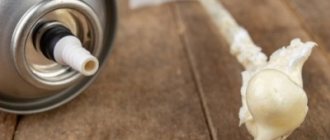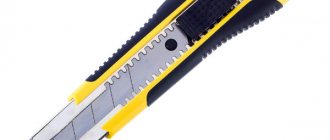We'll tell you what wipe off dried foam from various surfaces. Frozen assembly room
foamclear
much more difficult. If the main layer can simply be cut off, then the yellow remains
scrub off
not so easy.
Polyurethane foam is a polyurethane foam sealant that has high insulating properties and good adhesion to various materials. The porous structure of the chemical compound provides reliable protection from external noise and temperature changes. The substance is used to fill cracks, seams and inaccessible cavities.
After being forced out of the container, the liquid building material quickly hardens. The mounting medium does not respond to changes in humidity and air temperature, does not conduct electric current and does not crumble.
Polyurethane foam sealant is actively used for installing doors and windows for several reasons:
- hardens quickly;
- attaches to any type of coating;
- protects metal elements from corrosion;
- consists of environmentally friendly components;
- guarantees a long period of operation;
- does not require the use of additional tools.
The use of foam for installation is characterized by some nuances:
- for the building material to harden, access to fresh air is necessary;
- You cannot carry out insulation in the cold - the lower the air temperature, the longer the composition will harden;
- cylinders with high-quality mounting agents have a high cost;
- The sealant is not suitable for external finishing - it must be covered with facing material.
Wipe off dried polyurethane foam - how quickly it hardens
After applying polyurethane foam to any material, it hardens. The process takes place in two stages:
- Setting - within 20 minutes from the moment of contact with the surface, the outer layer of insulation dries. At this stage, the foam looks like a pasty porous mass that gradually expands.
- Curing is the internal hardening of the sealant. Depending on the ambient temperature, moisture level and brand of installation agent, hardening lasts from 4 to 12 hours.
Before filling the cracks, it is necessary to protect the door leaf from contamination with building materials. All areas that may get foam are sealed with masking tape or film. Read also: “Insulation with polyurethane foam”
How to ensure surface protection when working with polyurethane foam
Even a professional builder cannot boast of the complete absence of unwanted lumps of foam. Therefore, if it is impossible to avoid polyurethane foam stains, it is necessary to protect all surfaces from them. Repair experts recommend following three rules.
- Work clothes. Be sure to pick up things that you will throw away with a light heart after renovation. It is very difficult to wash construction foam from clothes. Remember that most often your hands and hair suffer from working with foam. Therefore, be sure to wear rubber gloves and do not take them off under any circumstances. Pull a hat over your head or tie a scarf, completely hiding your curls under the headdress. Neglecting the rule can lead to an unplanned haircut.
- Rescue oilcloth. Don't rely on your super accuracy. Light foam can quickly contaminate adjacent surfaces. Therefore, before starting work, prepare the area by covering with film all objects located in the area of work with sealant.
- Vegetable oil. This is another home trick that will help protect varnished or painted surfaces from foam. Before work, generously lubricate them with vegetable oil. In this case, lumps of sealant, even if they get to the surface, will not stick. Polyurethane foam does not have the ability to adhere to oily coatings.
Useful tips
There are a few tricks that you can use to make your life easier:
- Do not remove protective films from windows and doors until work is completed;
- next to the surfaces to be treated you need to stick masking tape or just pieces of newspapers or papers;
- carry out the work in stages. After each stage, take a break and inspect the work site in order to notice shortcomings in time and eliminate them without delay.
How to wipe dried foam from hands and other parts of the body?
If you are lazy and do not wear gloves when performing repair work, the sealant can easily get on your hands.
Attention! Trying to wash off fresh product with water is useless. Upon contact with liquid, its volume rapidly increases.
Here are a few ways to wash foam from your hands at home when it has already dried:
- salt bath. An excellent method tested by many repairmen. Fill a small container with water, dissolve 2 tbsp in it. l. salt and immerse your hands there for 10 minutes. Residues can be easily removed from the surface of the leather with pumice or fine sandpaper. After the procedure, you need to lubricate your hands with cream.
- generously lubricate your hands or other dirty parts of the body with vegetable oil. A rich cosmetic cream is also suitable. The products must be left on for at least 20 minutes;
- minor stains can be easily removed with soap. You need to make a hot bath for your hands, dissolving a large amount of soap shavings in water. Keep your hands in the soapy solution until the liquid cools;
- Removal with acetone is suitable for people with non-sensitive and not prone to irritation skin. Soak a cotton pad generously in acetone and wipe off the stains.
You can only clean your hands properly using home or professional products. You cannot simply peel off dried foam, this can lead to skin damage.
Oil
Refined sunflower oil - who would have thought that it could be a help in the fight against hardened polyurethane foam. However, the oil “works”, but not always. Polyurethane is not a fat-soluble substance. Therefore, sunflower oil, like most types of solvents, is effective until the polymerization process is completed.
Simply put, it can only wash away fresh or not completely “dried” consequences of polyurethane foam. To do this, the problem area should be generously lubricated with oil and left for about half an hour, after which it should be worked well with a rag. This method is the safest for delicate surfaces.
Removing fresh foam
As soon as foam gets on your skin, you should immediately remove it with a damp cloth or cloth. Do not rub the stain on the skin, so as not to aggravate the situation.
You can clean fresh foam sealant using traditional methods, for example, salt, dimexide, gasoline, sunflower oil. Start with the options that are most gentle on the epithelium.
Vegetable oil
The method will not harm the skin, but to be effective you will have to stock up on time and patience.
- Heat the oil slightly and soak a cotton pad in it.
- Place it on the contaminated area and leave for half an hour.
- Wash your hands thoroughly with soap.
Attention! The oil for the procedure should be warm, but not hot, so as not to get burned.
Salt
If the contamination is minor, you can use coarse table salt for cleaning. Rub your hands thoroughly with salt and then rinse with water.
Nail polish remover, kerosene, gasoline, acetone
These products will only bring results if the construction foam on the skin has not had time to dry completely. Soak a cloth in the liquid and wipe off the dirt. At the end of the procedure, be sure to wash your hands and lubricate with nourishing cream.
If nail polish remover is not available, use acetone. You can also remove foam from the skin with kerosene or gasoline; they are used in a similar way.
Vinegar
To clean windows, vinegar is used undiluted. It is applied for 5-10 minutes for effect. Remove with a sponge.
Dimexide
Before scrubbing the foam with dimexide, you should assess the extent of the contamination. If large areas are stained, it is better to choose another method, since the medicine, being absorbed into the body through the pores, can cause a side effect due to an overdose.
Detergents
Any detergent (washing powder, dishwashing gel, etc.). In order to wipe your hands this way, you need to:
- prepare a hand bath with hot water and a cleaning agent added to it;
- keep your hands in this composition for about a quarter of an hour;
- wash the skin in any usual way;
- carry out the moisturizing procedure.
Is it possible to wipe off dried polyurethane foam with alkali and acid?
Aggressive chemicals actively attack the composition of the sealant, destroying it. But they can cause serious skin burns; under no circumstances should they be used to cleanse hands.
The only safe option is a steam bath with soda, which is known to be alkaline. Add a couple of tablespoons of soda to hot water and hold your hands over the container for half an hour. After this procedure, the softened sealant can be easily washed off.
Special solvent
It must be purchased before work begins. The release form is an aerosol, which simplifies operation and increases efficiency. A gun is used for cleaning, with which foam is applied. You just need to spray the substance over the contaminated area, and then rinse off the foam under running water.
This solvent is used in strict accordance with the instructions. If you are deciding how to clean the foam from your hands after it has gotten on your skin, then the aerosol will deal with this problem quite quickly. But in cases where the building material has already hardened, it is useless to use such a solvent.
Wipe off dried foam with Kudo Foam Remover
Foam Remover is a remover of hardened polyurethane foam. The product is intended for removing polyurethane composition from plastic, metal and other surfaces with a non-porous structure.
Thanks to its convenient packaging, Kudo spreads well over the surface. Cost – from 140 rubles for a volume of 210 ml. Read reviews here and here.
Wipe off dried Soudal foam
The product is intended for removing polyurethane foam from a wide range of types of surfaces. The product comes with a spatula and brush for ease of use.
Soudal is suitable for cleaning frames, window sills and glass. The remover should not be used on brass, copper or zinc metal surfaces. Price – from 600 rubles per 100 ml. Read reviews here.
Wipe off dried foam Penosil Cured PU-Foam Remover
The cleaner is a highly effective product that comes in an aerosol can. The solvent is intended for removing hardened polyurethane foam from:
- doors,
- door frames,
- windows, etc.
Using Penosil allows you to remove dirt from accidental staining during installation. This is a one-component, easy-to-use product. The manufacturer also has a separate cleaner for removing uncured foam. Price – from 300 rubles.
Wipe off dried Polynor Cleaner foam
The cleaner is designed to remove polyurethane foam and non-hardening Polynor insulation from various surfaces. The product is suitable for treating window frames, window sills and glass. The product is based on acetone.
Polynor is sprayed onto the stained area of the plastic window. Cost - about 200 rubles per bottle. Read reviews here.
Wipe off dried Tytan foam
The stores offer a wide range of Polish Tytan products, including construction foams and foam removers. The manufacturer produces universal products for removing both uncured and hardened foam from various surfaces.
Wipe off dried Profflex foam
Profflex is designed to remove uncured polyurethane foam and clean the gun itself. The drug is suitable for processing:
- doors and windows,
- slopes,
- clothes, etc.
Cleaning of mounting structures is carried out using an adapter sprayer. The cost for 0.5 liters is about 120 rubles. Read reviews here.
Wipe off dried foam Quilosa Orbafoam Remover
The cleaner softens and removes dried polyurethane foam from various surfaces. The mixture of components contained in the product is life-threatening if inhaled and comes into contact with the skin, so it is better not to use Quilosa Orbafoam Remover to clean your hands.
Wipe off dried Bau Master foam
The cleaner from a Russian manufacturer does not contain aggressive components and carefully cleans various surfaces, including the skin of hands and clothing, from fresh construction foam. The gentle product does not cause mechanical or chemical damage.
Wipe off dried polyurethane foam with white alcohol
White spirit is an excellent effective means for removing fresh foam at home.
Cleaning with special products
We should start with the fact that there are ready-made solutions for removing polyurethane foam - removers and sprays, which can be purchased at hardware stores. But not everything is so simple.
Firstly, these are very caustic compounds that can harm both paintwork and other coatings, and the material itself. Secondly, there are situations when the foam needs to be washed off here and now, but you need to go or drive somewhere to get special equipment. Thirdly, washes and sprays to remove foam are not the cheapest pleasure that you can afford to clean a small area of the surface.
That’s why there are little tricks that allow you to solve the issue efficiently, inexpensively, and sometimes without any financial costs at all.
Mechanical ways to wipe your hands off dried polyurethane foam
Mechanical methods of removing contamination from polyurethane foam from hands will have to be resorted to in cases where this process has not been completed while this building material has not yet had time to harden.
In order to mechanically wipe your hands from polyurethane foam, you can use one of the following methods.
Wipe off dried polyurethane foam using coarse table salt
In order to wipe your hands from polyurethane foam using salt, you must perform the following steps:
- prepare the required amount of salt (depending on the level of contamination);
- treat the surface of the skin of the hands on which the foam has come in contact with salt (do not press hard and rub the salt into the skin so as not to cause serious mechanical damage);
- wash your hands under running water using any usual detergent;
- treat the skin with any moisturizer.
Advice! Using this method, you can scrub the skin only with minor dirt.
Scrub off dried polyurethane foam using a stiff brush or pumice stone
The algorithm of actions should be as follows:
- prepare a hand bath with hot water;
- steam your hands in the bath (the duration of the procedure is from 10 to 15 minutes);
- thoroughly lubricate your hands with Vaseline, vegetable oil or any cream with a greasy texture;
- using a brush with stiff bristles or pumice, you need to thoroughly scrub the skin and clean it of any remaining building material;
- Wash your hands using regular cosmetic soap and moisturize them with cream.
Wipe off dried foam using washing powder
You can wipe off dirt from your hands using this method quite quickly, which will save you a lot of time. However, it should be borne in mind that this method is effective only on small and relatively fresh stains. To do this, follow these steps:
- wash your hands using any washing powder;
- rinse them under running water;
- moisturize the skin.
In order to enhance the effect of the procedure, it is recommended to use a brush with stiff bristles or a hard sponge during the washing process.
Scrub dried foam using any cosmetic scrub
This method is only suitable for minor stains and will not help to wipe off already dried building materials. The sequence of actions in this case is completely similar to the process of removing foam from the skin of the hands using coarse salt.
Dimexide
This inexpensive drug is freely available at any pharmacy. The result of its use exceeds all expectations. Pharmaceutical dimexide is the abbreviated name for dimethyl sulfoxide, an organic solvent with incredible penetrating ability.
In the literal sense of the word, dimethyl sulfoxide does not dissolve polyurethane foam. Having the ability to seep into microscopic cracks at the molecular level, it quickly destroys the structure of polyurethane foam, including its adhesive component, and thus easily separates it from any surface, such as fabric, making it effective for clothing. Dimexide may be the only salvation for cleaning delicate surfaces from polyurethane foam. These include varnished wood, laminate, linoleum, plastics and others.
So, in order to clean the surface from polyurethane foam, its frozen flakes should be coated with dimexide using a brush and left to “sour” for 20-25 minutes. After this time, wipe off with the rough side of a sponge or a rough rag, then rinse the cleaned area thoroughly with soap and then with clean water.
The nuances of removing frozen foam
If for certain reasons it was not possible to clean the skin of your hands in a timely manner, you will have to think about how to wipe off the dried polyurethane foam. Solvents do not affect the sealant in its solid state. Any abrasive means of mechanical action will be suitable for this purpose: a hard brush, pumice stone. Coarser grit sandpaper will also work.
Tip: Before you begin mechanical treatment, you should steam the skin by immersing your hands in hot water for a few minutes (no more than 10 minutes).
Sequence of actions at the stage of cleaning dried foam:
- hands are lubricated with high-fat cream or oil, which will reduce the intensity of the impact of the abrasive surface on sensitive skin;
- brush/pumice is soaped;
- It is necessary to clean the skin of foam carefully and at the same time provide sufficient pressure so that the sealant layer begins to peel off.
If you succeed in removing the foam, you need to wash your hands and then apply the cream again.
How to remove polyurethane foam from various surfaces
Upholstered furniture and carpets
It happens that the sealant is used inappropriately, and unsightly stains form on carpets and upholstered furniture. How to remove polyurethane foam from such surfaces? The same essential solvents, Dimexide or acetone, will help. Use a generously dampened rag to thoroughly moisten the stain. As practice has shown, the foam is removed quite well after this.
You can also deal with such stains using a soap solution available to everyone. After thoroughly moistening a rag in this solution, it should be placed on the resulting stain. After some time it will become wet and it will be possible to remove it.
Plastic windows
It happens that builders turn out to be not such excellent professionals as they claim, and after their work your newly installed brand new windows “shine” with unsightly spots. How to put them in order? First, you will have to carry out manual cleaning and remove most of the foam with a knife or other object, being careful not to damage the structure of the material. After this, you can begin to remove the stain.
In the event that the insidious foam has not had time to dry well, vinegar, acetone, gun washing liquid, and sunflower oil will be excellent helpers. Dimexide or a special store-bought product that is specifically designed to remove dried foam stains can combat dried foam.
The algorithm of actions is the same when working with any substance: apply it to the stain, leave for a while, remove the remaining stain with a hard sponge. It is recommended to wash the area of contamination with soapy water, then with clean water, and then wipe dry.
Varnished surface
When working with a varnished surface, you should not use “strong” solvents; they will certainly damage the surface. The most effective way is to remove foam that has not completely dried. If time is not lost, the foam is removed quite well.
If the stain was discovered later, you will have to resort to “chemistry”, but you need to choose more gentle substances.
Any of these substances must first be tested in an inconspicuous area.
If the test method has revealed that no preparations are suitable and damage the coating, you can use a saline solution. It’s quite simple to prepare: stir 15 g of salt in a glass of water. Moisten the stain with the liquid and wash it off using a brush.
Linoleum and laminate
You can deal with stains of polyurethane foam on laminate and linoleum using the same Dimexide or acetone. These products must be applied to the previously cut stain and then removed along with the remaining stain.
Acetone often leaves unsightly stains on the floor covering. If this scenario does not suit you, it is better to refuse it. You'll have to go to the store to look for a product designed to combat stains on “delicate” surfaces, which include linoleum and laminate.
Wooden doors
Splashes of scattered foam will also not decorate the doors of your home, which is why you need to get rid of them here too. Foam that gets on a wooden door must first be cut off, and then the door leaf must be cleaned with sandpaper. If the door is not varnished, the stain will be completely invisible. But on varnished surfaces the mark will still remain, so you will have to mask it by applying varnish on top.
You can remove small splashes of foam using fine salt or soda.
Metal doors
Any foam that gets on the metal door must also be removed. The most gentle way is to use sunflower oil. It must be applied to areas from which as much foam has been cut off as possible, and wait until the substance begins to break down under the influence of warm oil. Using a clean sponge, the foam is carefully removed, the door is washed with a soap solution and then with clean water.
In the same way, remove foam from metal doors using Dimexide or solvent. Before you begin, you need to know how any of these substances interact with the material that was used to make the door.
You can get rid of foam on the front door using a hot iron. Only the door should not have a glossy finish!
To work, in addition to the iron, you need to have a sheet of clean paper and a piece of cotton fabric. Apply paper directly to the stain and place fabric on top of it. A hot iron is applied to the resulting structure and held until the foam begins to melt and stick to the paper. During the process you will have to replace several sheets of paper.
Laminated door
After cutting off the frozen foam “at the root,” we treat it with a special surface cleaner for polyurethane foam, which is sold in a hardware store.
This product is specially designed for removing foam from various surfaces, but before use, be sure to check the resistance of the door leaf to such an aggressive solvent.
Still, the laminated surface has little strength and low resistance to both chemicals and mechanical stress. If no stains appear on the wrong side after checking, you can start soaking and then rubbing off the stains with a hard sponge.
Door coated with eco-veneer
Eco-friendly veneer is an artificial coating on interior doors, which has a texture reminiscent of natural veneer. Thus, such doors have certain cleaning features if foam gets on them during installation.
On the one hand, the artificial polymer is more resistant to both chemical and mechanical influences compared to natural veneer, so you can use a special cleaning agent for polyurethane foam or dimexide. Of course, with caution and preliminary checking in an inconspicuous area, these substances are still solvents.
On the other hand, eco-veneer has a corrugated structure compared to plastic or MDF, so scrubbing will require more effort.
Cleaning decorative inserts
Interior doors can be decorated with glass inserts. If polyurethane foam gets on this part, it is removed in the same way as from the surface of a full glass door.
However, caution should be exercised when using oils and products containing acetone. They will not harm glass or stained glass, but they are not allowed to come into contact with wood coated with varnish or paint, or eco-veneer. Chemicals remove not only the sealant, but also the top layer of the decorative coating. Oil that gets on a wooden door will leave greasy stains on it that cannot be removed.
Brick wall
A brick or concrete wall, as well as a plaster partition, can be easily removed from foam streaks using salt water with a small amount of soap or vinegar added to it.
The foam adheres very weakly to all of the above surfaces.
Wallpaper
If the wallpaper in your home is also damaged, partial repairs are inevitable. It is almost impossible to clean off the foam stuck to the wallpaper without damaging the wallpaper. The easiest way would be to cut out the damaged areas and glue new elements in their place.
A special spray has been developed for cleaning metallographic materials. But even with its help, work must be carried out carefully.
Ceramic tile
Sealant can be removed from ceramic tiles with table vinegar or solvent. Even nail polish remover can do the job. The foam practically does not eat into the tiles; most of it remains on the surface.
It is more convenient to trim foam from glossy tiles with a metal spatula. When working with matte tiles, it is better to use wood.
If foam does get on the tiles, you should not try to wipe it off immediately, thereby rubbing it even more. You need to wait until the sealant dries, and only then begin to fight the unnecessary stain.
Automobile
To clean cars from foam, UV guns and special products are used that will help remove residual sealant from the paintwork. After work, you will need to polish the surface.
Cloth
It is almost impossible to avoid getting construction materials on clothes during repairs. And fabric surfaces are the most difficult to clean. But it will still be possible to wash the polyurethane foam from clothes. This is not easy to do, because... Even a work suit can be ruined by many products. It is important to check in advance how a particular substance will affect the fabric to avoid discoloration and damage.
How to remove foam from clothes:
- Cut off the bulk of the dried substance, being careful not to damage the fabric. A regular knife is ideal.
- Dampen a rag with a substance that can destroy the foam structure. A solvent in the form of gasoline (white spirit), pure gasoline, Dimexide or acetone is suitable. You just need to apply the rag to the dirty area for a few minutes.
- Wash clothes in the classic way. This should only be done after all traces of foam have been removed.
Features of removing traces from various areas of the window structure
The approach to removing polyurethane foam from windows must take into account which surface the contamination is on. Depending on the type of material, the cleaning approach is adjusted.
Glass
It is better to remove the sealant from the glass after it has hardened. The main mass is carefully cut off, avoiding scratching the glass.
Stains are treated with any of the above remedies. Acetone-containing solvents, white spirit and special preparations for cleaning the mounting gun are also suitable.
Plastic
It is recommended to clean the plastic at the joints after the polyurethane mass has hardened. It is better to scrape it off with a plastic spatula rather than a metal one. Further processing can be carried out with Dimexide or sunflower oil.
Windowsill
The sill of plastic windows can be made of ceramics, plastic or wood. For PVC surfaces, treatment with Dimexide and special polyurethane foam solvents is suitable. Stone-like ceramic window sills can be cleaned with any of the household and professional products.
But if the surface is wooden and varnished, the use of such products is prohibited. In this case, foam removal must be carried out when the polyurethane has just begun to set. Its edge is picked up and carefully removed. To make the procedure easy, it is advisable to wait until the sealant has stopped getting dirty, but has not yet hardened.
If the foam has frozen on a varnished window sill, you will have to use a salt solution:
- Pour a glass of water into a bowl.
- Add 1 tbsp. l. salt.
- Stir.
- The solution is applied to the affected area of the window sill.
- Leave for 5 minutes.
- Erase the mark with a wet sponge.
If all the above methods do not help clean the varnished surface, you will have to sand the window sill and re-varnish it.
How to remove polyurethane foam from a gun
The gun, which facilitates the process of applying foam to the desired areas, becomes dirty during operation. And if you ignore cleaning it, it will very quickly become unusable. In order for the “helper” to serve for a long time, it is necessary to clean it even after a short period of work.
It is better, of course, to use a special solvent. It works great even when the sealant has had time to harden. When the sealant hardens, it is ideal to first remove the hardened foam using available means, and only then use a cleaner.
Hair and wool
It also happens that foam can get on your hair, or your beloved pet may get dirty in it as it runs past the repair work. The adhesion between hair and foam is extremely strong, so it needs to be removed while still fresh.
Important! Under no circumstances spread the foam over the entire length of your hair!
It is best to use an industrial solvent for construction foam or acetone if a specialized product is not available. Alas, strands that cannot be cleaned will have to be cut with scissors.
Chemical cleaning with solvents
The best way to deal with frozen foam “flaws” is ethyl acetate or solvents that contain it – R-645, R-647. It is this that serves as the basis for special liquids for removing polyurethane foam. Ethyl acetate is used to remove foam from PVC windows after sealing, washing mounting guns, tools, and most types of decorative and building materials. It is enough to moisten a piece of rag with it and wipe the contaminated area well, then rinse the area with soapy water.
You can use acetone, gasoline, white spirit, and car paint solvents. They also show a good effect, but only with “fresh” foam. In any case, regardless of whether we are talking about non-polymerized or already hardened foam, you should try to remove it as much as possible and only then use solvents.
Precautionary measures
Foam is a substance with a high degree of adhesion. This means that the foam molecules penetrate deeply into the material and bind tightly to it.
Polyurethane foam is used to blow in cracks when installing doors
While installing the door structure and blowing in cracks, stick a protective film on those areas where the product can get in. This is better than then standing for hours and trying to wash off the frozen mass.
Protective film is not a 100% guarantee of cleanliness. Droplets can still get into some places, and even those who have been working with the installation substance for many years are not immune from this.
Sources
- https://VseoDveri.ru/montazh/chem-otteret-montazhnuyu-penu-s-dveri-sposoby/
- https://wizard-aerosol.com/germetiki/chem-otmyt-montazhnuyu-penu-s-lyuboy-poverhnosti-10-sposobov.html
- https://DomZnatok.ru/uborka/sovety/kak-otteret-montazhnuyu-penu/
- https://DecorObot.ru/stirka/chem-otmyt-montazhnuyu-penu.html
- https://poleznii-site.ru/dom/byt/kak-otteret-montazhnuyu-penu-s-ruk.html
- https://home-gid.com/sovety/kak-i-chem-otteret-montazhnuyu-penu-s-ruk.html
- https://yborka.online/uborka/montazhnaya-pena/chem-udalit-s-dverej
- https://hozzi.ru/sovety/chem-otmyt-penu-montazhnuyu-s-ruk
- https://adella.ru/home/cleaning/chem-otmyt-montazhnuyu-penu.html
- https://topalexdoors.com/kak-smyt-montazhnuyu-penu-s-dveri/
- https://chistota.info/chem-otteret-montazhnuyu-penu-s-dveri.html
- https://nn.tbmmarket.ru/help/useful-articles/item/4519/kak-ochistit-montazhnuyu-penu/
- https://uteplitel-minol.ru/remont-i-stroitelstvo/chem-otteret-zasohshuyu-montazhnuyu-penu.html
- https://srazuchisto.com/uborka/kak-otmyt-montazhnuyu-penu.html
3 740











